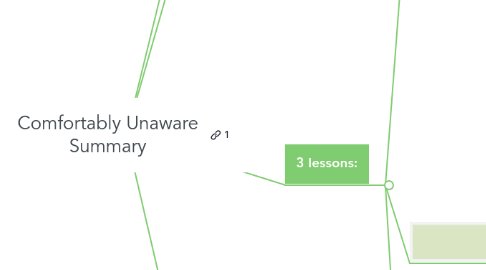
1. 1-Sentence-Summary:
1.1. Comfortably Unaware is a well-researched compendium on how our food choices and animal agriculture impact the well-being of the whole planet.
2. Favorite quote from the author:
2.1. "Our current food choices detrimentally affect climate change and global warming more so than do all the cars, planes, trucks, buses, and trains used worldwide." - Richard Oppenlander
3. 3 lessons:
3.1. Animal production requires big areas of land, which usually take away from rainforests.
3.1.1. Meat and other animal products consumption has a severe impact on the environment.
3.1.1.1. Scientists have proven beyond doubt that raising livestock simply requires incomparably more resources than plant production.
3.1.1.2. One of these resources is land.
3.1.1.3. Raising animals requires doubling down on the use of farming lands because, on top of the space needed for the livestock itself, farmers also need vast areas to grow food for them.
3.1.1.3.1. This causes the destruction of valuable wildlife areas in order to acquire the necessary amount of land.
3.1.1.3.2. Sadly, a lot of that land comes from cutting down the rainforests, which are arguably the most valuable natural formations in terms of maintaining ecological balance.
3.1.2. Rainforests are considered “the lungs of the Earth,” as they absorb millions of tons of carbon dioxide and produce the oxygen which is vital for human (and other animals) survival.
3.1.2.1. They are also home to numerous species that are key for the local and global ecosystem.
3.1.3. According to Raintree, we are currently losing 78 million acres of rainforests every year.
3.1.3.1. This means 150 acres per minute!
3.1.3.2. This is not sustainable
3.1.3.3. And much of this destruction comes from animal farming.
3.2. We can easily solve world hunger by a mass transition to a plant-based diet.
3.2.1. If people, on the global level, adjusted the proportions between their animal and plant consumption – we could easily produce more food with the same amount of resources.
3.2.1.1. Or even – use up fewer resources and still feed every person in the world.
3.2.2. Oppenlander claims that if a sufficient chunk of the grains we use to feed livestock was distributed to humans instead, we could overcome the problem of world hunger in no time.
3.2.3. According to an ecology professor, David Pimentel, “More than half the U.S. grain and nearly 40 percent of world grain is being fed to livestock rather than being consumed directly by humans.”
3.2.3.1. This means that with the grain it feeds animals, the U.S. could instead provide food for 800 million people.
3.2.4. Livestock consumes even more water than humans do.
3.2.4.1. Worldwatch Institute states that “agriculture uses about 70 percent of the world’s available freshwater, and one third of that is used to grow the grain fed to livestock.”
3.2.5. This shows us that any type of agriculture is already incredibly costly.
3.2.5.1. The animal agriculture, however, costs our planet indefinitely more than the plant one.
3.3. One of the biggest problems caused by animal agriculture is pollution.
3.3.1. Raising livestock always comes with expelling huge amounts of pollution – both into the air and water.
3.3.1.1. Animal production is responsible for around 20% of the global greenhouse gas emissions.
3.3.1.1.1. Just for comparison, all the world’s transportation only accounts for 13%.
3.3.2. A big part of the greenhouse gases from animal agriculture is methane.
3.3.2.1. Because, according to science, “methane is roughly 30 times more potent as a heat-trapping gas.”
3.3.2.1.1. This means that it heats up the atmosphere 30 times more effectively than carbon dioxide.
3.3.3. Another type of pollution the livestock produces is their faeces.
3.3.3.1. The first problem is the sheer amount of it.
3.3.3.1.1. According to Oppenlander, U.S. animal farming alone releases over 5 million pounds of excrement per minute.
3.3.3.1.2. That’s quite a lot of sh*t to deal with – both literally and figuratively speaking.
3.3.4. Also those excrements are usually full of hormones, antibiotics and pesticides that often get released to Earth’s water systems.
3.3.4.1. This way, they re-enter the food chain, for example through being consumed by fish.
3.3.4.1.1. Some of that stuff can end up on your plate.
